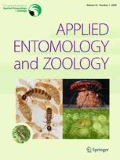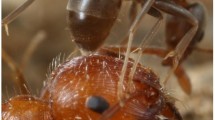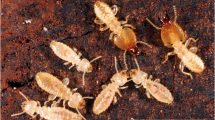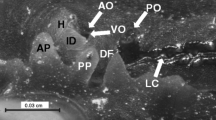Abstract
Soldiers of the Japanese subterranean termite Reticulitermes speratus Kolbe possess the caste-specific terpenoid hydrocarbon β-selinene in the frontal gland. They secrete the compound as an alarm pheromone when facing danger. Furthermore, while dispersing the nestmate workers it simultaneously recruits the nestmate soldiers and enhances their aggression level. This study aims to confirm that the alarm pheromone might have defensive effects against facultative termite-hunting (termitophagous) ants, such as the Asian needle ant Brachyponera chinensis Emery. According to our behavioral bioassay, which provided fresh termite bodies, the ponerine ants used in the study immediately fed on the termite workers but avoided feeding on the soldiers. However, they avoided feeding on the workers when presented with the soldiers. Furthermore, extracted chemicals from the termite soldiers showed similar effects on the foraging activity of the ponerine ants, while those from the workers had no such effect. Soldier chemicals also clearly repelled the ponerine ants when they were treated at the entrance of a glass tube in which the worker bodies had been placed. It is most likely, therefore, that the termite soldier secretions serve as a chemical defense against the termitophagous ponerine ants.





Similar content being viewed by others
References
Antmaps.org. http://www.antmaps.org. Accessed 1 Oct 2015
Austin JW, Szalanski AL, Uva P, Bagne AG, Kence A (2002) A comparative genetic analysis of the subterranean termite genus Reticulitermes (Isoptera: Rhinotermitidae). Ann Entomol Soc Am 95:753–760
Bergström G, Löfqvist J (1970) Chemical basis for odor communication in four Lasius ants. J Insect Physiol 16:2353–2375
Billen J, Morgan ED (1998) Pheromone communication in social insects: sources and secretions. In: Breed MD, Winston ML, Espielie KE, Vander Meer RK (eds) Pheromone communication in social insects. Westview Press, Oxford, pp 3–33
Blum MS (1969) Alarm pheromones. Ann Rev Entomol 14:57–80
Blum MS (1981) Chemical defenses of arthropods. Academic Press, New York, p 574
Bolton B (1995) A taxonomic and zoogeographical census of the extant ant taxa (Hymenoptera: Formicidae). J Nat His 29:1037–1056
Bolton B, Alpert G, Ward PS, Naskrecki P (2006) Bolton’s catalogue of ants of the world: 1758–2005. Harvard University Press, Cambridge, p 222
Bradshaw JWS (1981) The physicochemical transmission of the two components of a multiple chemical signal in the African weaver ant (Oecophylla longinoda). Anim Behav 29:581–585
Bradshaw JWS, Baker R, Howse PE (1975) Multicomponent alarm pheromones of the weaver ant. Nature 258:230–231
Bradshaw JWS, Baker R, Howse PE (1979) Multicomponent alarm pheromones in the mandibular glands of major workers of the African weaver ant (Oecophylla longinoda). Physiol Entomol 4:15–25
Brand JM, Blum MS, Lloyd HA, Fletcher DJC (1974) Monoterpene hydrocarbons in the poison gland secretion of the ant Myrmicaria natalensis (Hymenoptera: Formicidae). Ann Entomol Soc Am 67:525–526
Costa-Leonardo AM (1998a) Morphology of the frontal weapon in the soldier caste of Cornitermes cumulans (Isoptera, Termitidae). Rev Bras Ent 41:191–197
Costa-Leonardo AM (1998b) The frontal weapon of the termite soldier Serritermes serrifer (Isoptera, Serritermitidae). Cienc Cult 50:65–67
Costa-Leonardo AM (2001) The frontal weapon of the termite Armitermes euamingnathus Silverstris (Isoptera, Termitidae, Nasutitermitinae). Rev Bras Zool 18:411–419
Costa-Leonardo AM (2004) A new interpretation of the defense glands of Neotropical Ruptitermes (Isoptera, Termitidae, Apicotermitinae). Sociobiology 44:391–402
Costa-Leonardo AM, Casarin EF, Lima JT (2009) Chemical communication in Isoptera. Neotrop Entomol 38:1–6
Costa-Leonardo AM, Kitayama K (1991) Frontal gland dehiscence in the Brazilian termite Serritermes serrifer (Isoptera: Serritermitidae). Sociobiology 19:333–338
Costa-Leopnard AM, Hifig I (2010) Pheromones and exocrine glands in Isoptera. In: Litwack G (ed) Vitamins and hormones, vol 83. Academic Press, New York, pp 521–549
Dewsbury DA (1978) The comparative method in studies of reproductive behavior. In: McGill TE, Dewsbury DA, Sachs BD (eds) Sex and behavior: status and prospectus. Plenum, New York, pp 83–112
Eggleton P (2000) Global patterns of termite diversity. In: Abe T, Bignell DE, Higashi M (eds) Termites: evolution, sociality, symbioses, ecology. Springer, Netherland, pp 25–51
Hölldobler B, Wilson EO (1990) The ants. The Belknap Press, Cambridge, p 743
Leal IR, Olivera PS (1995) Behavioral ecology of the Neotropical termite-hunting ant Pachycondula (=Termitopone) marginata: colony founding, group-raiding and migratory patterns. Behav Ecol Sociobiol 37:373–383
Matsuura K (2002) Colony-level stabilization of soldier head width for head-plug defense in the termite Reticulitermes speratus (Isoptera: Rhinotermitidae). Behav Ecol Sociobiol 51:172–179
Nguyen TT, Akino T (2012) Worker aggression of ant Lasius japonicus enhanced by termite soldier-specific secretion as an alarm pheromone of Reticulitermes speratus. Entomol Sci 15:422–429
Nguyen TT, Kanaori K, Hojo MK, Kawada T, Yamaoka R, Akino T (2011) Chemical identification and ethological function of soldier-specific secretion in Japanese subterranean termite Reticulitermes speratus (Rhinotermitidae). Biosci Biotechnol Biochem 75:1818–1822
Park YC, Kitade O, Schwartz M, Kim JP, Kim W (2006) Interspecific molecular phylogeny, genetic variation and phylogeography of Reticulitermes speratus (Isoptera: Rhinotermitidae). Mol Cells 21:89–103
Prestwich GD (1979) Chemical defense by termite soldiers. J Chem Ecol 5:459–480
Prestwich GD (1983) Chemical systematic of termite exocrine secretions. Ann Rev Ecol Systemat 14:287–311
Prestwich GD (1984) Defense mechanisms of termites. Ann Rev Entomol 29:201–232
Prestwich GD, Bierl BA, Devilbiss ED, Chaudhury MFB (1977) Soldier frontal glands of the termite Macrotermes subhyalinus: morphology, chemical composition, and use in defense. J Chem Ecol 3:579–590
Roisin I, Everaerts C, Pasteels JM, Bonnard O (1990) Caste-dependent reactions to soldier defensive secretion and chiral alarm/recruitment pheromone in Nasutitermes princeps. J Chem Ecol 16:2865–2875
Šobotonik J, Hanus R, Kalinová B, Piskorski R, Cvačka J, Bouguignon T, Roisin Y (2008) (E, E)-α-Farnesene, an alarm pheromone of the termite Prorhinotermes canalifrons. J Chem Ecol 34:478–486
Stuart AM (1969) Social behavior and communication. In: Krishna K, Weesner FM (eds) Biology of termites, vol 1. Academic Press, New York, pp 193–232
Teranishi Y (1929) Habits and distributions of Japanese ants II. Zool Mag 41:312–332
Vander Meer RK, Alonso LE (1998) Pheromone directed behaviour in ants. In: Breed MD, Winston ML, Espielie KE, Vander Meer RK (eds) Pheromone communication in social insects. Westview Press, Oxford, pp 159–192
Verheggen FJ, Haubruge E, Mesher MC (2010) Alarm pheromones—chemical signaling in response to danger. In: Litwack G (ed) Vitamins and hormones, vol 83. Academic Press, New York, pp 215–240
Vrkoc J, Krecek J, Hrdy I (1978) Monoterpenic alarm pheromones in two Nasuitermes species. Acta Entomol Bohemoslov 75:1–8
Wilson EO (1955) A monographic revision of the ant genus Lasius. Bull Mus Comp Zool 113:1–201
Wilson EO (1971) The insect societies. Oxford University Press, London
Wilson EO, Regnier FE (1971) The evolution of the alarm-defence system in the formicine ants. Am Nat 105:279–289
Yashiro T, Matsuura K, Guénard B, Terayama M, Dunn RR (2010) On the evolution of the species complex Pachycondyla chinensis (Hymenoptera: Formicidae: Ponerinae), including the origin of its invasive form and description of a new species. Zootaxa 2685:39–50
Acknowledgments
We thank Honorary Professor Ryohei Yamaoka for valuable comments on our study, and Mr J. Ryder for proofreading the English of the manuscript. We would also like to thank the three anonymous reviewers for their comments.
Author information
Authors and Affiliations
Corresponding author
Rights and permissions
About this article
Cite this article
Iida, M., Akino, T. Defensive effect of soldier-specific secretion by Reticulitermes speratus (Isoptera: Rhinotermitidae) on the facultative termitophagous ponerine ant Brachyponera chinensis (Hymenoptera: Ponerinae). Appl Entomol Zool 51, 111–116 (2016). https://doi.org/10.1007/s13355-015-0379-y
Received:
Accepted:
Published:
Issue Date:
DOI: https://doi.org/10.1007/s13355-015-0379-y




